Spanning more than 450 years, the works come from a diverse group of artists from across the globe, including Edward Mitchell Bannister, Agostino Brunias, Dominique Fung, David Hockney, Letitia Huckaby, Mineo Mizuno, Kenjiro Nomura, Sandy Rodriguez, Betye Saar, Lilly Martin Spencer, Nari Ward, and Qiu Ying.
SAN MARINO, Calif.—The Huntington Library, Art Museum, and Botanical Gardens acquired works of art in 2023 made by a wide range of artists, from a master painter of the Ming Dynasty to contemporary art icons. The acquisitions reflect The Huntington’s commitment to broadening its collections to become more inclusive, while making cross-curatorial connections among its extensive holdings of library, art, and botanical materials. In addition to the previously announced major acquisitions of Qiu Ying’s Zhou Dunyi Admiring Lotuses (ca. 1530s) and Betye Saar’s Drifting Toward Twilight (2023), additional works by African American, Asian American, and British artists, among others, joined the collections. In media ranging from assemblage to painting to sculpture, the 2023 acquisitions span nearly five centuries and represent an array of styles.
Highlights from The Huntington’s 2023 Art Acquisitions

Edward Mitchell Bannister (American, born in Canada, 1828–1901), Untitled (Walking Through a Field), ca. 1870s, oil on canvas, 22 x 42 1/4 in. | The Huntington Library, Art Museum, and Botanical Gardens.
Untitled (Walking Through a Field) is a rare New England landscape by the trailblazing African American painter Edward Mitchell Bannister. The scene symbolically links past, present, and future as a solitary figure traverses a wheat field toward a distant lake. Like many of the paintings that Bannister made toward the end of the 19th century, its subject matter does not present a clear reading. He was born in Canada to a Barbadian father and a mother of Scottish ancestry. After the death of his parents, Bannister moved to Massachusetts, where he met his wife, Christiana Carteaux, a businesswoman and hairdresser. Both were devoted abolitionists. Through the support of his wife and a community of prominent abolitionists in Boston and later Providence, Rhode Island, Bannister became a respected and successful painter of landscapes, portraits, and seascapes. He served as one of the original board members of the Rhode Island School of Design in 1878. Two years later, he helped found the Providence Art Club, an organization composed of professional and amateur artists and art collectors that was created to stimulate the growth of art within the city. Motivated by an article in the Boston Herald, which claimed that Black artists were inherently incapable of becoming great artists, Bannister was determined to beat the odds. He achieved critical acclaim in 1876 when his work Under the Oaks received first prize in painting at the Philadelphia Centennial Exposition. When he was denied entry into the exposition to accept the award because of his race, his fellow artists rallied to his defense.

Agostino Brunias (Italian, active in the West Indies, ca. 1730–1796), Free Women of Dominica with a Child, 1770–80s, oil on canvas, one of six paintings: 11 3/4 x 9 1/8 in. each. | The Huntington Library, Art Museum, and Botanical Gardens.
Born and trained in Rome, Agostino Brunias began his career as a Grand Tour painter on the European continent before moving to England, where he worked under the famed architect and interior designer Robert Adam. In 1764, he sailed to the British West Indies (a subregion of North America in the Caribbean Sea and North Atlantic Ocean), eventually taking up residence on the island nation of Dominica. He traveled widely in the region, and his portrayals of local society—a consistent theme in his surviving paintings—provides a rare record of Indigenous, Afro-Caribbean, and Creole culture, specifically the role of free people of color within colonial society. The Huntington’s newly acquired six paintings form what is thought to be a complete set, produced on identically sized canvases. They are in their original frames and depict scenes that include women engaged in conversation and an Indigenous family from the nearby island of Saint Vincent. Each painting is characteristic of Brunias’ vivid palette, his sensitive rendering of local dress and social distinctions, and his nuanced treatment of subtle gradations in skin color.
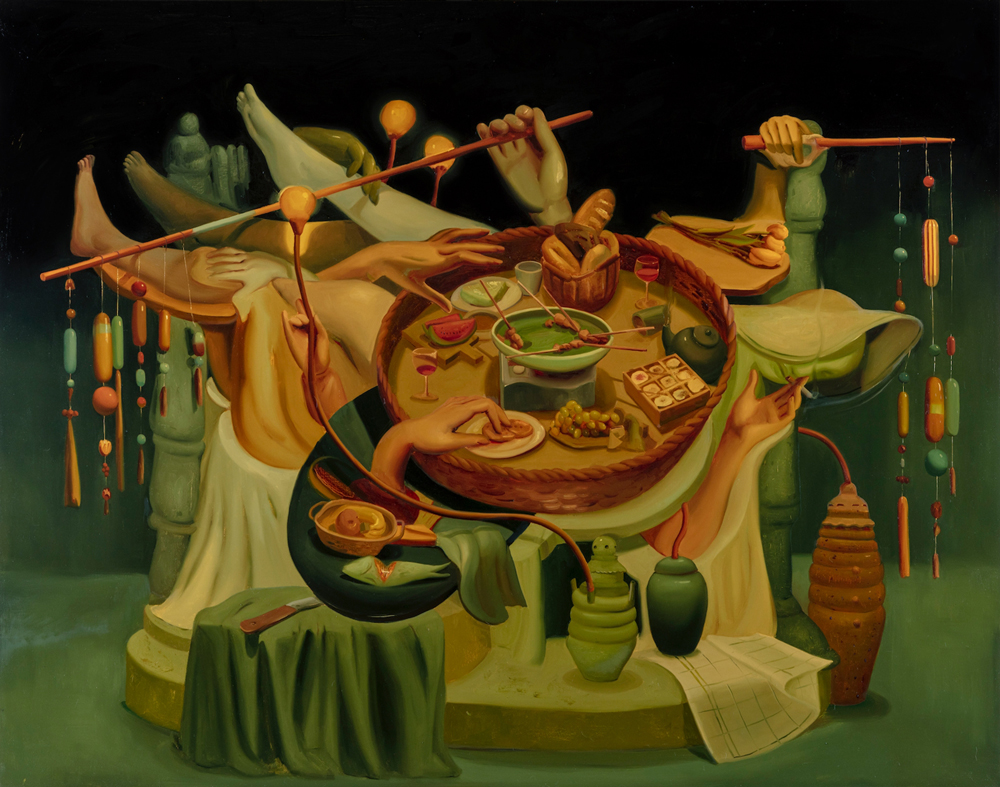
Dominique Fung (Canadian, b. 1987), Sans Les Mains, 2022, oil on canvas. Purchased with funds from Dominic and Ellen Ng. © Dominique Fung, 2022, courtesy of Jeffrey Deitch Gallery and Nicodim Gallery. | The Huntington Library, Art Museum, and Botanical Gardens.
Sans Les Mains (2022), a monumental painting by Chinese Canadian contemporary artist Dominique Fung, features a tangle of hands, legs, arms, and objects—trays, vases, French brie and baguettes, and an East Asian–style grill—comingling. Like much of Fung’s work, this painting references and critiques a work from the Western canon, specifically Édouard Manet’s Le Déjeuner sur l’herbe (1863). Instead of Manet’s famous nude woman reclining on the grass next to a picnic, Fung’s woman is herself a picnic of Cantonese snack food—complete with skewers, a snack box, tea, watermelon, and cut fish. Fung’s exploration of the uncomfortable collapse of person and object speaks to the objectification of Asian women by male and Orientalist gazes. Things that are often ornamental in art history—like ceramic vases and the female body—are made strange, mysterious, and even uncomfortable in Fung’s painting, which resists being devoured. The painting is on view in the Virginia Steele Scott Galleries of American Art.
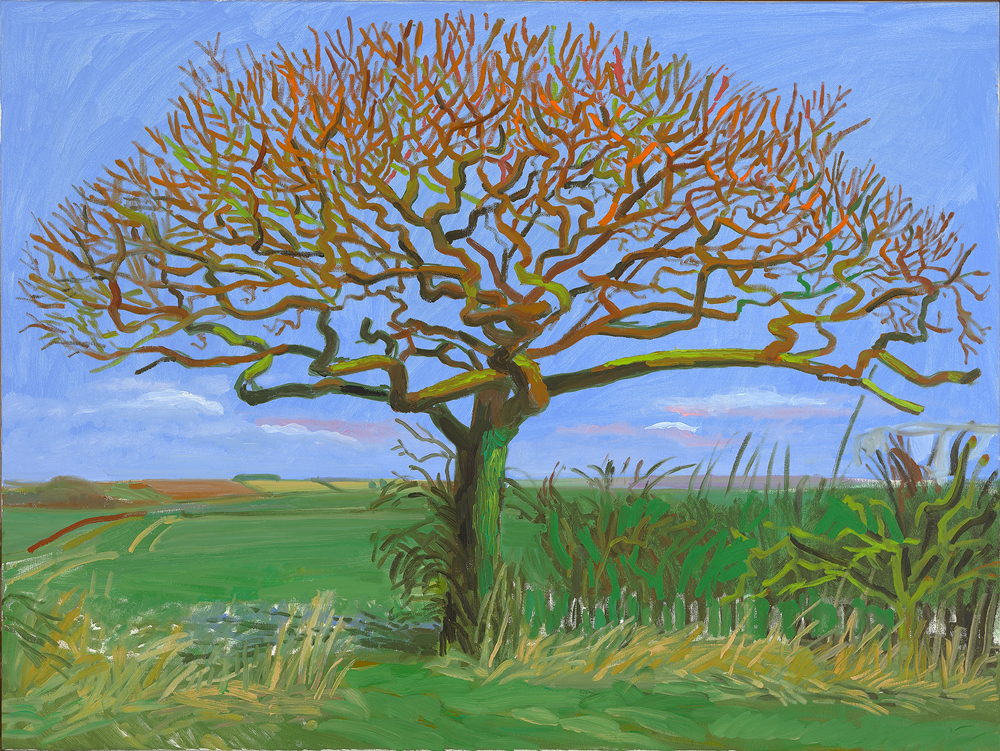
David Hockney, Tree on Woldgate, 6 March, 2006, oil on canvas, 36 x 48 in. The Huntington Library, Art Museum, and Botanical Gardens. Gift of Gregory Evans in memory of Dagny Janss Corcoran. | © David Hockney. Photo credit: Richard Schmidt.
One of the most influential artists of the 20th century still at work today, Hockney transformed the medium of painting by developing a type of freely worked and realistic representation rendered in blazing colors. He is well known for his portraits of friends and acquaintances, but from roughly 2000 to 2014, he focused on large landscapes depicting the Yorkshire countryside in which he was raised. Tree on Woldgate belongs to this body of work and is the first oil painting by the artist to enter The Huntington’s collection. Installed on the second floor of the Huntington Art Gallery, the painting is located near John Constable’s View on the Stour Near Dedham (1822), one of the collection’s icons of landscape painting. Like Hockney’s work, Constable’s painting depicts the landscape near his childhood home, using it to convey the experience of place, as well as its emotions and sensations. Working 200 years apart, the two artists marshal the unassuming elements of the landscape—a leafless tree in the case of Hockney; a workaday canal for Constable—to create paintings in which personal associations combine with detailed observations of nature and weather as vehicles of expression.
Letitia Huckaby merges documentary photography with fiber material, interweaving historical and contemporary narratives about underrepresented communities in the Black American South. She created the two works acquired by The Huntington during a three-month artist residency at Artpace in San Antonio. Her residency project, And Thy Neighb(our), resulted from interviews with and photographs of 15 Black women and men who self-identified as refugees or immigrants in the local community. The series title references biblical text (Luke 10:27) and was used to inspire communitywide concern for underserved immigrant communities, especially those originating from countries with majority Black populations. These two works from the series represent immigrant women within Huckaby’s project: “Chaulinne,” a Black woman who identifies as Haitian American, and “Shwanda,” a Black woman who identifies as Jamaican Nigerian American. Highly accomplished professionally, the women present two different immigrant journeys influenced by their countries of origin. Through her project, Huckaby discovered that the experiences of Black immigrants are often obscured in national narratives on immigrant identities.
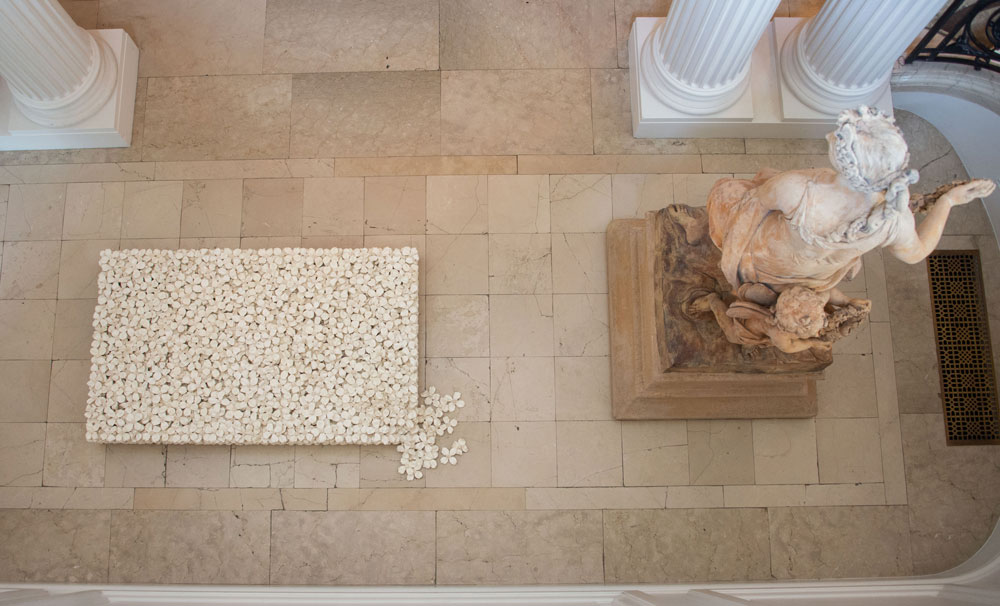
Mineo Mizuno (American, born in Japan, 1944), Thousand Blossoms, 2020, ceramic. Courtesy of the artist and Gagosian Gallery. © Mineo Mizuno, 2022. | The Huntington Library, Art Museum, and Botanical Gardens.
Mineo Mizuno’s Thousand Blossoms (2020) is composed of 3,000 handmade ceramic dogwood blossoms stacked into a tightly composed rectangle. As a gesture of poetic disruption, the corner of the rigid stack seems to collapse, and a few blossoms scatter on the floor. Mizuno’s choice of dogwood flowers refers to his own past and present environments: Dogwoods bloom in Japan, where Mizuno was born, and in California near the Sierra Nevada, where he maintains his studio. Mizuno’s artistic practice combines technical mastery of the ceramic medium with humanist meditations on the natural world and life cycles. The work is on view in the Huntington Art Gallery.
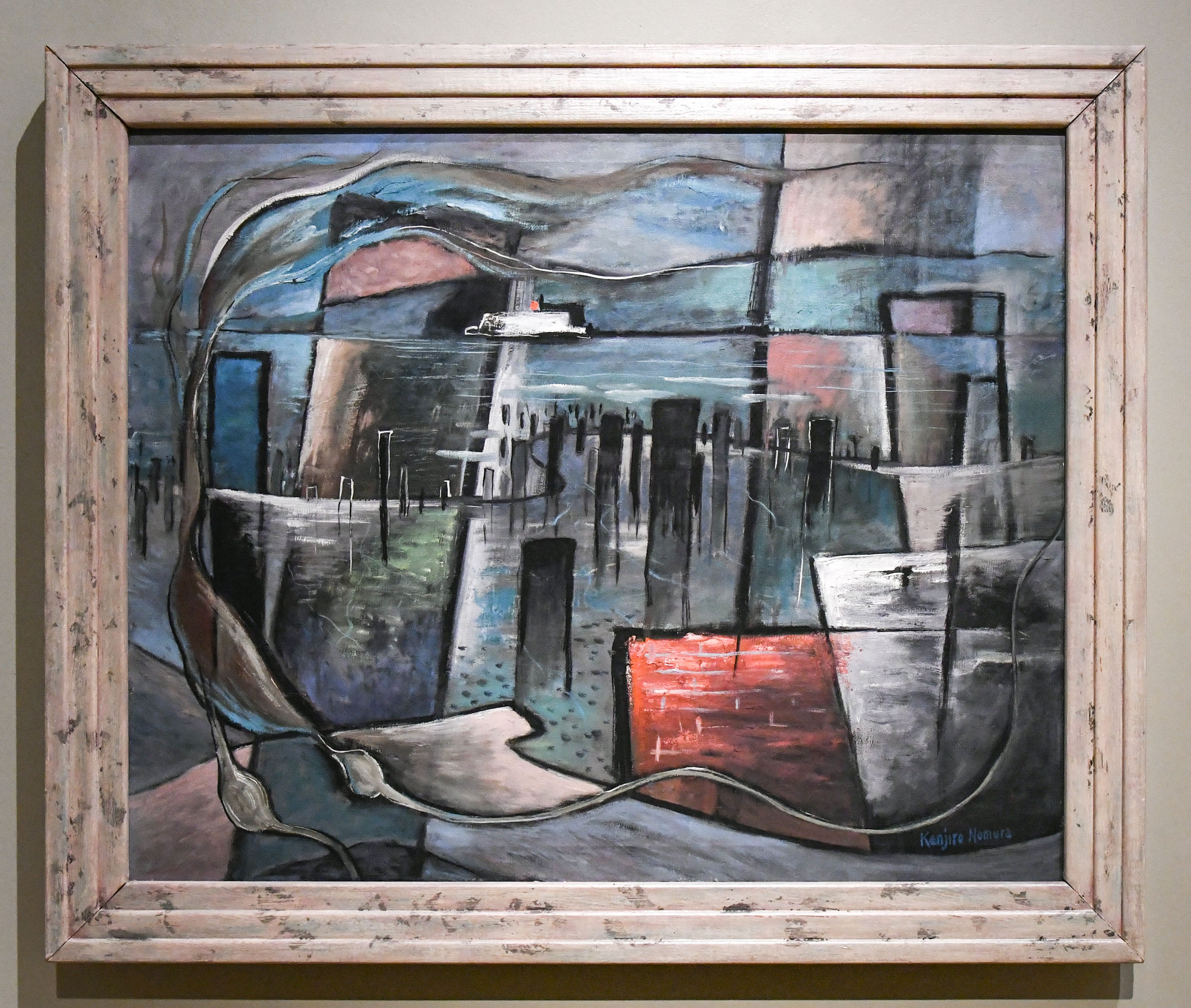
Kenjiro Nomura (American, born in Japan, 1896–1956), Puget Sound, 1947, oil on canvas. Gift of Robert Hori. Lisa Kidwell. The Huntington Library, Art Museum, and Botanical Gardens. | Photo by Linnea Stephan.
New acquisition Puget Sound (1947) by Japanese American painter Kenjiro Nomura features a cubist composition that depicts the Pacific Coast shoreline, marine life, and midcentury Seattle. Wood pilings in the ocean are framed by the tendrils of bull kelp and a line that suggests the fin of a stingray. On the horizon floats Seattle’s iconic ferry, the Kalakala. Nomura, who owned the Noto Sign Co., matured as a painter in the 1930s, depicting moody farm and street corner scenes. His life and career were tragically disrupted in 1942, when Executive Order 9066 mandated the incarceration of Japanese Americans on the West Coast; as a result, the Nomura family was forcibly incarcerated in the Minidoka War Relocation Authority camp in Idaho. Puget Sound was his first major painting after his return to Seattle in 1945, and it marked the beginning of his increasingly abstract style.
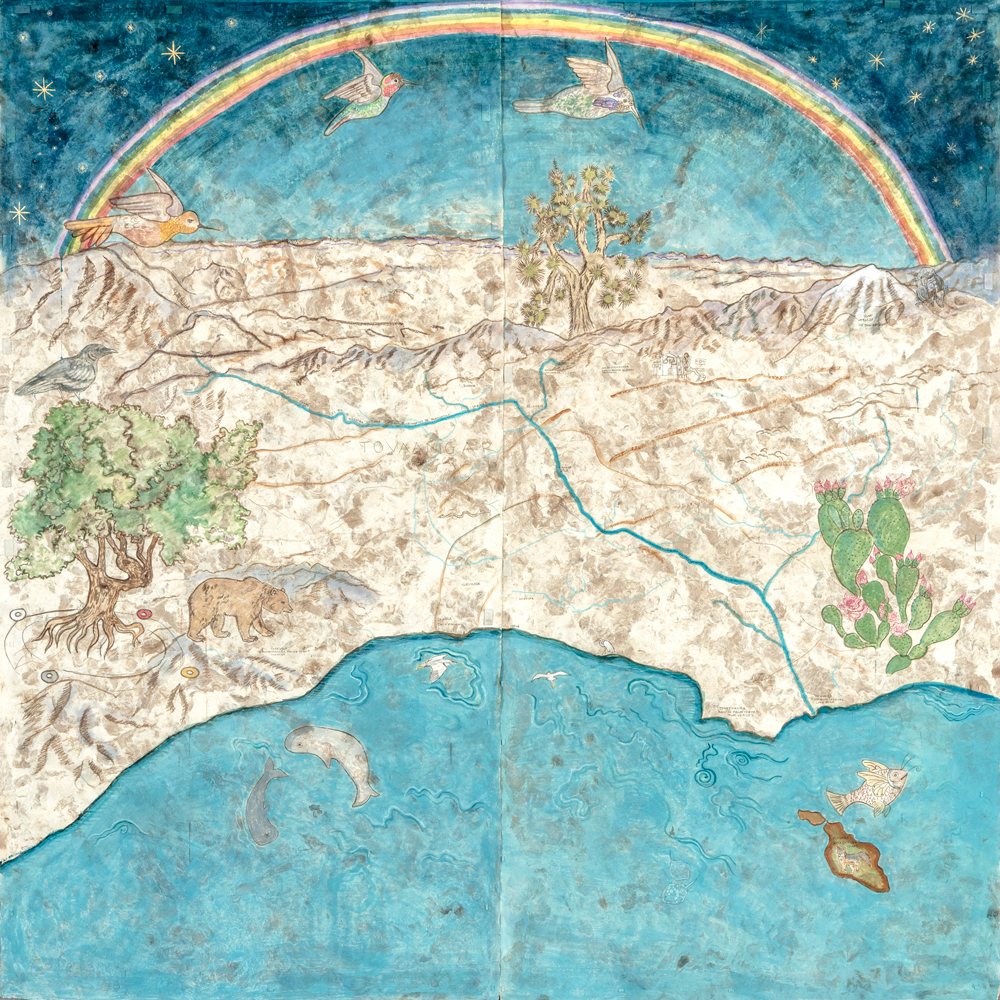
YOU ARE HERE / Tovaangar / El Pueblo de Nuestra Señora la Reina de los Ángeles de Porciúncula / Los Angeles (2021) by Sandy Rodriguez, in the Virginia Steele Scott Galleries of American Art at The Huntington. Photo: Joshua White / JWPictures.com. | The Huntington Library, Art Museum, and Botanical Gardens.
Los Angeles–based artist Sandy Rodriguez created YOU ARE HERE for “Borderlands,” the 2021 reinstallation of seven of the rooms in the Virginia Steele Scott Galleries of American Art, and the work was subsequently acquired this year. The 8-foot-by-8-foot watercolor is a multilingual map of the greater Los Angeles area, representing the topography, language, flora, fauna, and land stewardship in the region over time. It illustrates the movement and histories of peoples who have called—and continue to call—the area home. For the work, Rodriguez used locally sourced pigments and colorants, derived from mineral and organic sources, and 23-karat gold applied to amate paper, a native fig-bark paper that was traditionally used in Mexico but outlawed by the Spanish in the 16th century. Rodriguez was a 2020–21 Caltech-Huntington Art + Research Fellow.
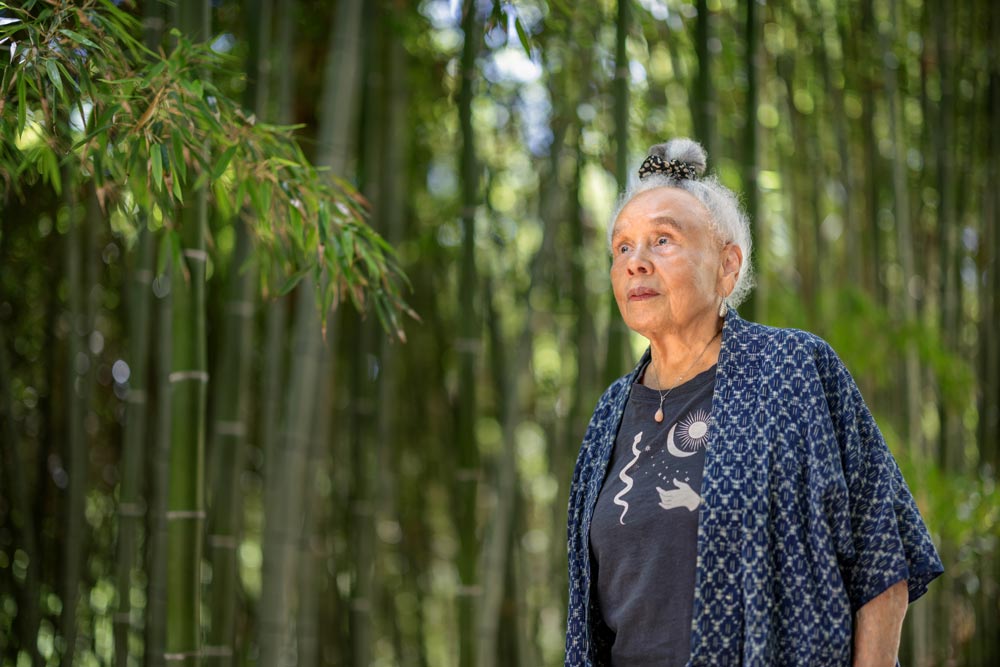
Betye Saar exploring a bamboo grove in the Japanese Garden at The Huntington, 2023. | Photo by Sarah M. Golonka. The Huntington Library, Art Museum, and Botanical Gardens.
The Huntington commissioned renowned American artist Betye Saar to create a large-scale work for the Virginia Steele Scott Galleries of American Art. Titled Drifting Toward Twilight, the site-specific installation features a 17-foot-long vintage wooden canoe and found objects, including birdcages, antlers, and natural materials harvested by Saar from The Huntington’s 207-acre grounds. It will be the centerpiece of an immersive exhibition, “Betye Saar: Drifting Toward Twilight,” co-curated by Yinshi Lerman-Tan, The Huntington’s Bradford and Christine Mishler Associate Curator of American Art, and Sóla Saar Agustsson, Saar’s granddaughter and the Huntington Art Museum’s special programs and digitization assistant. The exhibition debuts on Nov. 11 and will remain on view for two years, and the work will become a permanent part of The Huntington’s American art collection.
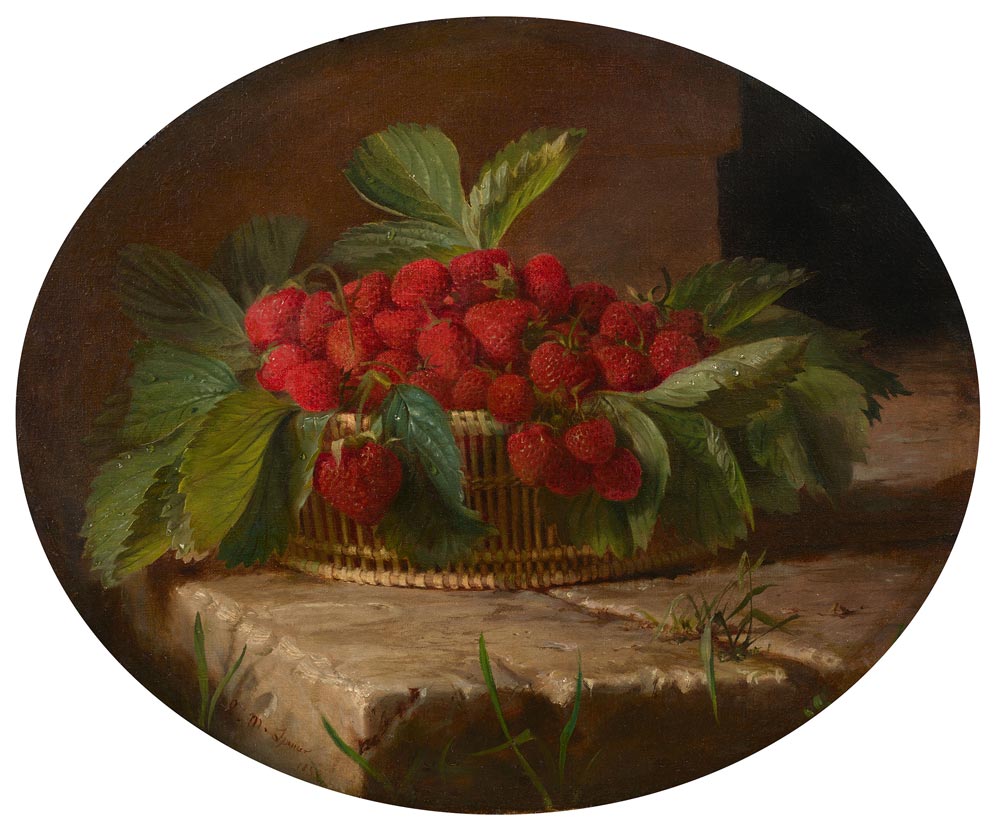
Lilly Martin Spencer, Strawberries, 1859, oil on canvas, 14 1/4 x 17 in. (oval). | The Huntington Library, Art Museum, and Botanical Gardens.
A basket full of plump, ripe strawberries glistens in the sun. Tiny droplets of water, likely remnants of the morning’s dew, sparkle along the strawberries’ red flesh and bright green leaves. Lilly Martin Spencer’s 1859 still-life painting Strawberries is a tour de force of naturalistic observation that engages multiple senses—sight, smell, touch, and taste—simultaneously, asking its viewers to imagine the scents and flavors the image evokes. Spencer was born in England but emigrated to the United States as a young girl. After training and exhibiting in Cincinnati, she married and moved to New York, where she continued to advance her career. Spencer embraced British writer John Ruskin’s philosophies and—like painters William Trost Richards and Henry Farrer, both of whom have drawings and prints at The Huntington—took note of his advice to “go to nature in all singleness of heart … rejecting nothing, selecting nothing, and scorning nothing.” Spencer’s painting exemplifies Ruskin’s influence with her careful depiction of the worn and cracked stone beneath the basket, the inclusion of weeds that poke through the stone’s cracks, and the nearly scientific level of focus she gives to the strawberries themselves—their serrated, veined leaves and the drops of water that cling to them.
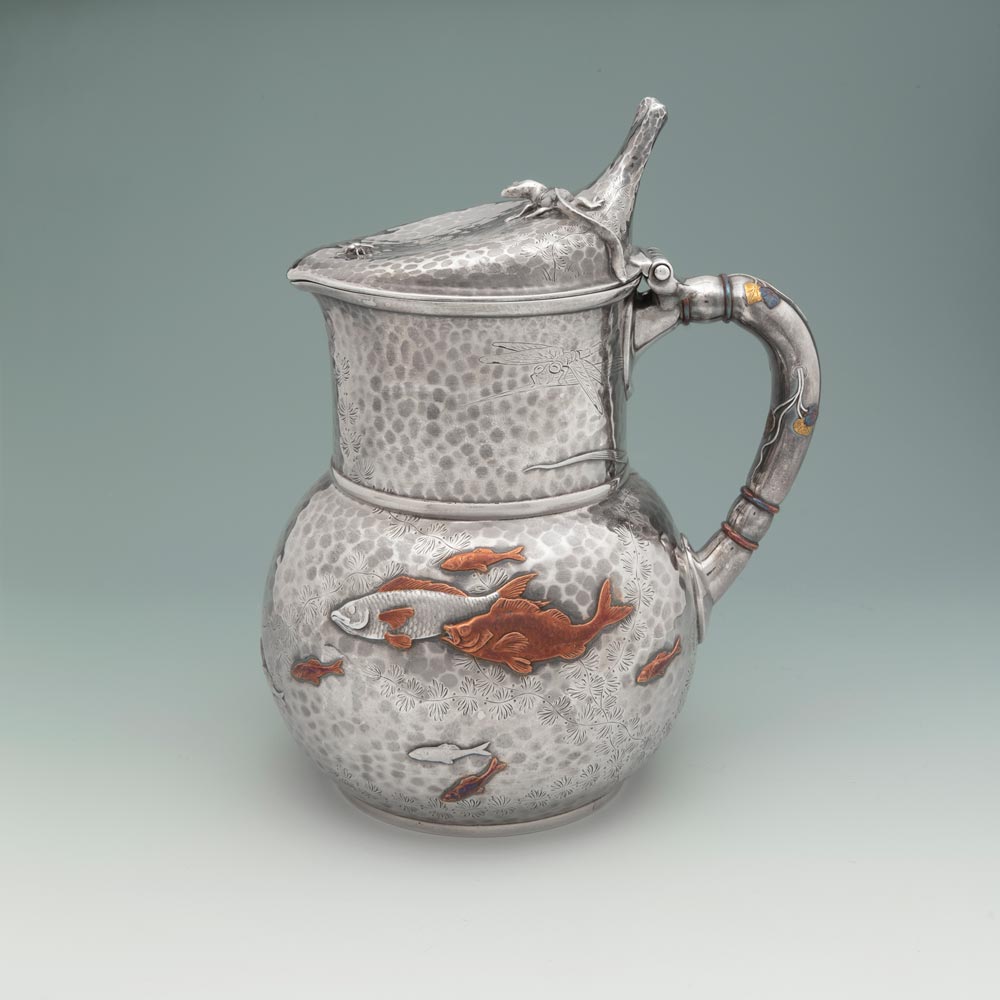
Tiffany & Co., Covered pitcher, ca. 1880, silver with mixed metals, 9 1/4 x 6 in., weight: 27 oz. (2 dwt). | The Huntington Library, Art Museum, and Botanical Gardens.
A pair of colorful carp swim amid aquatic plants while a watchful dragonfly alights on a blade of grass. A newt perched on a lily pad eyes a fly. These and other incidents of pond life are captured in the newly acquired lidded silver pitcher, one of Tiffany and Co.’s most celebrated early mixed-metalwork experiments in a Japonesque style. Inspired by the design aesthetic and technical mastery of Japanese metalwork and other decorative arts, Tiffany’s designers used applied mixed metals—gold and copper on silver—to create a lively, narrative scene that wraps around the vessel. The hand-hammered surface breaks up the reflection of the bright, polished silver as does the water in the pond, referring to the pitcher’s purpose to hold liquid.
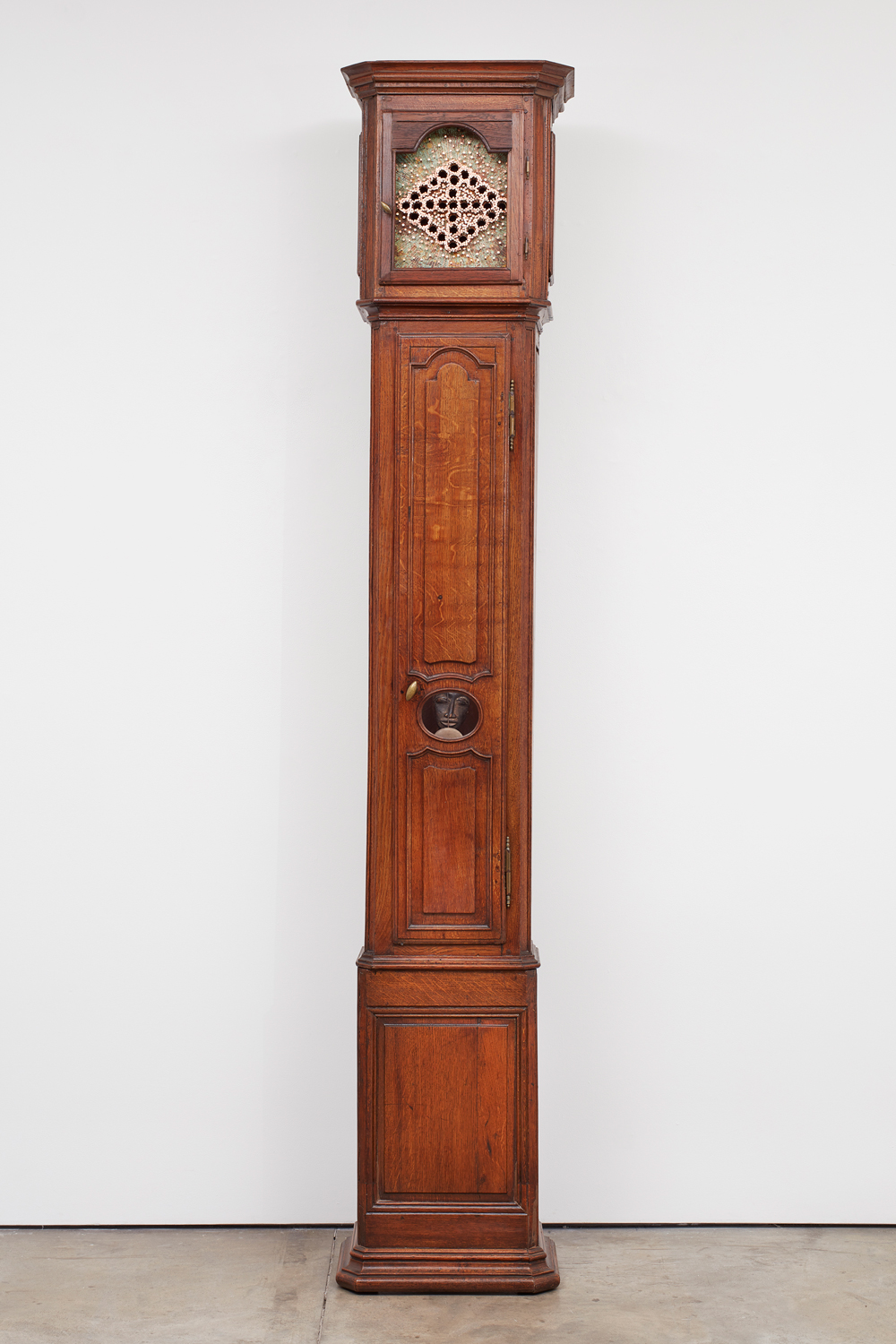
Nari Ward (American, b. 1963), Anchoring Escapement: Baule, 2018. Grandfather clock case, copper sheet with patina, copper nails, and African sculpture. 99 × 17 × 12 in. Courtesy of the artist and Lehmann Maupin, New York, Hong Kong, Seoul and London. Photographer: Matthew Herrmann.
Jamaican-born American artist Nari Ward is known for his deeply moving and provocative works of sculpture, installation, and assemblage. Often made of discarded objects found and collected in his New York neighborhood, his artworks create thought-provoking juxtapositions that interrogate aspects of American history and engage with the cultural sites that the work occupies. The Huntington has acquired Anchoring Escapement: Baule (2018), a tall case clock that’s part of Ward’s series called “Breathing Space,” which relates to the history of slavery. Inside the body of the clock, the artist has placed a West African wooden figure—visible through the window—which he sourced from a local African import store. In place of the clock face, he has added a diamond-shaped Kongolese cosmogram, which he first encountered in the First Baptist Church in Savannah, Georgia, one of the earliest African American churches in the United States and a site on the Underground Railroad. Drilled into the floorboards of the church, this symbol literally allowed escaping slaves who were hiding under the floorboards to breathe. Created with hammered copper nails, the symbol in Ward’s work also relates to the tradition of West African power figures with nailed surfaces—each nail signifying a misdeed within the community that is ritually hammered into the surface. Ward’s work is a profound critique of colonialism and how the 18th-century Enlightenment was underpinned by the trans-Atlantic slave trade. The title, referring to the act of escaping, could also refer to the “escapement” of an 18th-century clock, the part of the mechanism hidden behind the dial that keeps and regulates time.
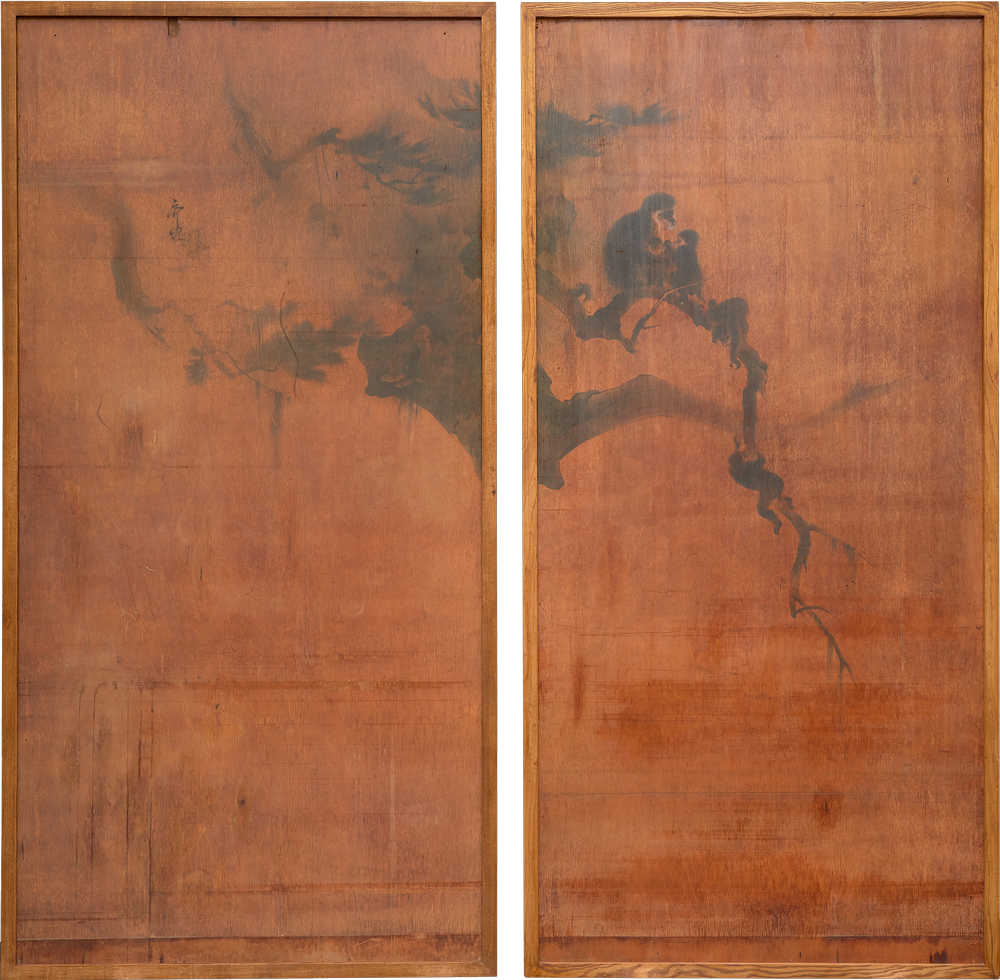
Tyrus Wong (American, born in China, 1910–2016), Dragon’s Den Mural, ca. 1935, oil and charcoal pencil on plywood, two panels: 96 x 48 1/16 in. each. | The Huntington Library, Art Museum, and Botanical Gardens. Tyrus Wong Family.
Widely recognized as a key figure in the history of Asian American art, Tyrus Wong is best known as the artistic visionary who shaped Disney’s iconic film Bambi (1942). The recently acquired, monumental mural stands 8 feet tall by 8 feet wide. From the top left corner, a composition of tree branches descends, rendered in oil and charcoal pencil. A family of five monkeys sits in this forest setting: A mother clutches a baby, and near her, three adolescents climb the branches, passing a fruit down the line. Wong painted this mural for the LA Chinatown restaurant the Dragon’s Den, which opened in 1935. The Den was the Depression-era business idea of Wong’s friend, Eddy See, who operated an art gallery in the mezzanine of his family’s successful store, F. Suie One. The restaurant operated only until 1942, after which this mural by Wong remained in the possession of the See family. The Huntington acquired the mural through the granddaughter of Eddy See, New York Times bestselling novelist Lisa See (b. 1955), who chronicled her prominent family’s history in the nonfiction memoir On Gold Mountain. In 2020, The Huntington acquired a major collection from the See Leong family, which features papers and photographs, including Wong’s hand-painted menus from the Dragon’s Den.

Qiu Ying (Chinese, ca. 1495–ca. 1552), Zhou Dunyi Admiring Lotuses, Ming dynasty (1368–1644), ca. 1530s. Ink and colors on silk. 45 3/4 x 22 7/8 in. Purchased with funds from June and Simon K.C. Li. | The Huntington Library, Art Museum, and Botanical Gardens.
Zhou Dunyi Admiring Lotuses is a rare hanging scroll painted by Qiu Ying (ca. 1495–ca. 1552), one of the most celebrated Chinese artists of the 16th century. He worked primarily in Suzhou—a city west of Shanghai with storied gardens that inspired The Huntington’s renowned Chinese Garden—and became famous for his meticulous depictions of literary themes. Qiu’s scroll depicts the philosopher Zhou Dunyi (1017–1073) relaxing in a thatched pavilion, contemplating the lotuses in the surrounding pond. The work evokes Zhou’s beloved essay “On the Love for the Lotus” 愛蓮說, in which he wrote that a gentleperson should rise above the turbidity of society to follow a path of modesty, just as a lotus rises above muddy pond waters to blossom into purity. The essay inspired the name Love for the Lotus Pavilion 愛蓮榭 at The Huntington’s Chinese Garden, whose pavilion overlooks a pond that bears a remarkable resemblance to the one in Qiu’s scroll. Zhou Dunyi Admiring Lotuses will be on view in the Huntington Art Gallery from Dec. 9, 2023, through March 4, 2024.
###
[EDITOR’S NOTE: High-resolution digital images available on request for publicity use. Request Images]
About The Huntington
The Huntington Library, Art Museum, and Botanical Gardens is a cultural and educational institution of global significance. Building on Henry E. and Arabella Huntington’s renowned collections, The Huntington supports research and promotes education in the arts, humanities, and botanical science through the growth and preservation of its collections; the development of a community of scholars, school programs, and partnerships; and the display and interpretation of its extraordinary resources for diverse audiences. The Huntington is located at 1151 Oxford Road, San Marino, California, 12 miles from downtown Los Angeles. Visitor information: huntington.org.
Contacts:
Thea M. Page, 626-405-2260, tpage@huntington.org
Jessica McCormack, 323-497-9308, huntingtonnews@huntington.org

